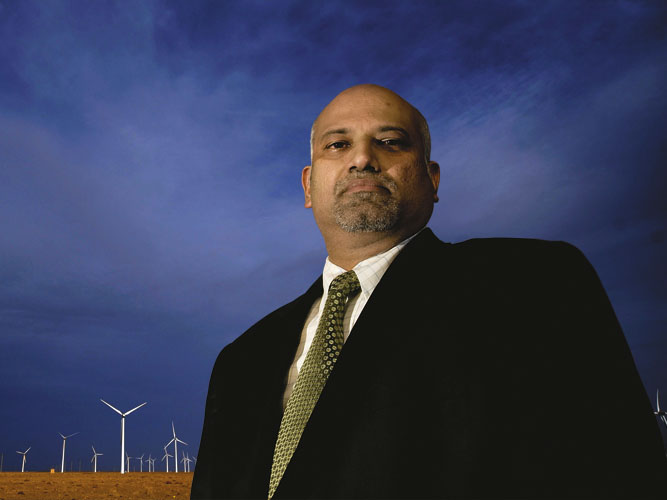
Where the Wind Blows
GE Energy is back in India for a second shot at wind energy
The year 2005 was a big one for India in wind energy. Alternative sources of energy were the next big thing to hit corporate consciousness. The government announced tax breaks and wind-turbine maker Suzlon Energy made its debut in the stock market with an initial public offering of Rs. 1,500 crore that was over-subscribed 45 times. But, GE Energy, the $29-billion arm of US conglomerate General Electric, pulled out of India the same year.
Local rival Suzlon had figured out that clients weren’t looking for windmills to generate electricity but to claim tax benefits — an 80 percent depreciation benefit in the first year of operation meant for a Rs. 100 crore investment in wind energy, a developer could deduct Rs. 80 crore out of his taxable income.
GE only managed to sell only 14 wind turbines in 2004-05. “It was primarily a fiscal benefit industry and it didn’t make sense for us to participate in that market because it was price-sensitive without any acknowledgement for technology,” defends Kishore Jayaraman, who took over as CEO of GE Energy India in 2007.
When the Indian market seemed to have all but forgotten GE Energy, word spread that the US giant has returned with a Rs.150 crore order. Coming as it does closely on the heels of rival BP’s exit from the wind energy market in India, GE’s comeback raised many questions. What does GE see in India now and will it be second-time lucky?
Sitting in his Gurgaon office, Jayaraman, 44, says the Indian market is getting to be more discerning and that has brought back GE. “Now we have found a couple of customers who want to be in this game long term so we have signed a deal with them. And we are noticing that more and more people want to be energy producers and developers. So that’s why we are re-entering the business,” he says.
He admits that the company has won its first order in India after 2005 but refuses to divulge details. An industry source says GE signed the Rs.150 crore contract with Bhoruka Power, a Bangalore-based power generation company.
GE’s timing couldn’t have been better. Market leader, Suzlon Energy, is in a sea of troubles and vulnerable to competitive onslaught. The last 18 months have seen Suzlon crippled by allegations of faulty turbines and a lot of its orders got cancelled. It controls half the Indian market.
GE is also on its way to build an assembly plant in India which Jayaraman claims should be up and running by early 2010. Its parent company GE has acquired Scandanavian company ScanWind which deals in advanced turbine technology. That should give GE Energy a boost.
But why is GE so sure that things will be different this time?
Paradigm Shift
Its optimism is primarily driven by the generation based incentive (GBI) scheme announced by the Ministry of New & Renewable Energy (MNRE) for grid-connected wind power projects earlier this year. Tax incentives will be given only for the amount of power produced, not for the number of turbines installed. Investors will get an incentive of Rs. 0.50 per unit of electricity for a period of 10 years in addition to the tariff, provided they do not claim the depreciation benefit.
According to consulting firm BTM Consult, GE narrowed the gap with Denmark’s Vestas, the world’s leading turbine manufacturer in 2008. Vestas had a market share last year of 19.8 percent, down from 22.8 percent in 2007, while GE’s share rose to 18.6 percent from 16.6 percent in 2007.
That’s impressive considering GE struggled initially. GE Energy bought the wind turbine business from Enron in 2002. “From 2002 to 2005 it was a very slow business, some 100 million dollars,” says Jayaraman.
When GE left India in 2005, the US wind energy industry got a boost because of Production Tax Credit (PTC), a generation-based incentive, offered by the US government to promote use
of renewable sources of energy.
Except for a similar, though, softer green policy, India has nothing in common with the US. If GE has to build scale in India it has no option but to localise. Jayaraman is doing exactly that. “As of today, I think we have identified almost 70 percent of the wind turbine components to be purchased in this country and vendors for the same. Some of these are already our suppliers and we take it to the rest of the world and some of these are people who will start doing it for us in the next 3 to 6 months,” he says.
GE Energy now has a sourcing team of almost 20 engineers based out of Bangalore and in the last 12 months GE has been working closely with potential suppliers to conduct technology compliance.
GE’s success will depend on how it is able to differentiate itself from existing players in the market. “It will be the technology,” says Jayaraman. Analysts are doubtful if the technology trick would be enough. “Most of the companies present in India today have proven technologies. There’s Suzlon Energy which has the advantage of REpower, Vestas and Enercon,” says Krishnakant Thakur, Senior Analyst at Quant Capital.
Jayaraman, though, believes the biggest challenge for him will be to deliver on what he calls the say do ratio. “Most of the times lots of things that should happen when they should happen as per what your customers tell you never happen in India,” he says.
Though born in Chennai, it is evident Jayaraman is new to India. The sooner he learns to work around it, the better for him. Or GE can kiss its India ambition goodbye.
(This story appears in the 09 October, 2009 issue of Forbes India. To visit our Archives, click here.)
Post Your Comment















